After a shockingly easy border crossing, our first week in Central America was filled with ancient Mayan temples, jungles, exotic wildlife, spelunking and cave tubing, swimming in rivers and lakes, and Guatemalan highway adventures.
We didn’t plan to cross the border into Guatemala on a Sunday afternoon. We had left Palenque early that morning, headed for the small, remote town of El Ceibo in the very corner of Chiapas, where we planned to spend the night and cross the border first thing in the morning. However, unlike on most driving days in Mexico, the road was smooth, easy, and had a minimum of topes, so we arrived in El Ceibo much earlier than we anticipated. When we found out that the customs stations were open until six we decided what the heck, it’s time so blow this popsicle stand and make a run for the border! We had done our research, we had all of our papers in order, and were mentally prepared for the throng of “helpers” trying to scam us, border officials trying not to help us, and mass confusion all along the way. But somehow none of that happened.
We drove up to the neat, clean, and quiet customs offices on the Mexico side and parked. Within twenty minutes we had handed over our Mexican vehicle import permit and received the deposit back, and had our passports stamped, with only one minor hiccup. Somehow when we entered Mexico in Tijuana and received our tourist visas the official there neglected to actually stamp Tim’s passport, so technically he had never entered Mexico. Fortunately, the official in El Ceibo didn’t really care and stamped Tim out of the country anyway. We then drove the 100m or so across the border and stopped at the offices on the Guatemalan side, where we pretty much had the place to ourselves. This part seemed a bit more confusing at first, especially since we didn’t have a chance to change pesos or dollars into quetzales before we crossed the border, but even that turned out to be easy. The officials were friendly and helpful, the man in the customs office even pushed back his lunch break so we wouldn’t have to wait for him to stamp our passports. We received our vehicle import permit, paid for the required fumigation, handed over vaccination papers for Hobie, and were on our way. No hassle, no searching of the van, no scamming. We glided into Central America a day earlier than anticipated with smiles on our faces. Having read a number of Central American border crossing nightmare stories, we do realize that our experience was a rare exception, likely due to the location and timing of our crossing, and that in no way should we expect to slip through future borders with such ease.
By nightfall we were tucked into quite possibly the only available parking space in the tiny island town of Flores. We slept in the van in front of Hostel Frida, where we met several other interesting travelers, including a couple from the states who were cruising Central America on their motorcycles. Flores is quaint and colorful, with steep, narrow alleyways and cobblestone streets. It was great place to spend our first night in Guatemala.

Lago Petén Itzá has been rising over the years, slowly submerging the streets and walkways that circle Flores.
Next on the tourist track was Tikal. We almost didn’t go. After reading the blogs of other overlanders with dogs who skipped Tikal because they couldn’t bring their dog into the park we thought maybe we too had seen enough ruins and didn’t want to deal with the hassle. Fortunately we changed our minds. We found a nice hotel right on the lake (the other side of Lago Petén Itzá from Flores) in the small town of El Remate where we could safely camp in the van and swim off the submerged dock. As soon as we pulled up we noticed an awesome contraption tied to the dock. Ten minutes later we met Jeff, a very friendly man from Florida, who was there to teach some Guatemalans how to fly their new boat-plane. Take a small rubber boat, add some hang gliding wings and a big fan and voila, a boat-plane!
It turns out that pilot Jeff is also a dog lover and offered to keep an eye on Hobie while we went to Tikal. Hobie, however, was not at all happy about being left with a stranger while we drove away in his home and apparently he talked and sang about it for several hours. He promptly forgave us when we returned.
If Yaxchilan is the baby bear and Palenque is the mama bear, then Tikal is definitely the big daddy papa bear of Mayan ruins. The numerous temples and other structures are amazing, and several of them have sturdy wooden staircases leading to their summits, which offer views of other temples poking out of the jungle. To top it off, Tikal National Park is in a huge biosphere reserve, which means the jungle is protected and intact, in contrast to the agriculturally fragmented jungle elsewhere. This means that wildlife abounds in and around Tikal. We were thrilled by the birds, spider monkeys, coatimundis, agoutis, and butterflies.
Heading south we got to experience the Guatemalan highway system. For the most part the going was easy with smooth roads, good signs, and little traffic. Occasionally we would come to sections with giant potholes and a few bridges that were out and replaced with sketchy-looking temporary ones. Then we came to the river crossing in Sayaxché. For some reason no one has built a bridge across the Río de la Pasión. Instead there’s a small ferry consisting of a platform with ramps on either side and two outboard motors on the downstream side. The technique was to fill the ferry on one side of the river, use the motors to push off, drift with the current a bit until the proper orientation was achieved, then gun the motors and hope to get to the other side. Unload, reload, repeat. We waited patiently for our turn to board and speculated on what would happen if one or both of the motors failed in the middle of the swift current.
When it was time to load we started forward in the bumper-to-bumper line, only to be forcefully cut off on both sides by cars and trucks pushing ahead of us that hadn’t waited in line. We realized we were going to have to be more aggressive if we were ever going to make it onto the platform, so we pushed our way forward. It turns out those line-cutters got placed on the sides of the ferry and we were front and center with a great view. This time when the ferry tried to push off it wouldn’t budge, there was too much weight in the back. The solution was to inch every car forward. When this didn’t work everyone was directed to inch forward even further, literally bumper to bumper. Finally, the pickup in the back reversed all the way to the back edge, gunned it forward and slammed on his brakes, screeching to a stop just behind the next car, transferring his forward momentum to the ferry. Whether this actually worked or not, eventually we started moving and made it safely across.
Our next adventure was exploring the awesome Candelaria Caves. The north and central regions of Guatemala are made up of almost all limestone, which makes for very cool geomorphology, including an abundance of enormous caverns. We found an amazing place to camp right on the edge of the river that runs through the Candelaria Caves, where we could swim in the cool, clear water and enjoy the sights and sounds of the jungle.
The following morning we explored the caves with three young guides, who were having at least as much fun as we were. First we walked through the vast caverns of a few very large dry caves, full of white stalactites. Then we crawled into some smaller passageways to explore, occasionally coming across broken fragments of old pottery. The caves were important in ancient Mayan ceremonies and we were told that these remnants were in fact archeological artifacts.
As we got deeper into the small passageways we started having to crawl on all fours. Suddenly we noticed something dark on one of the nearby stalactites. It turned out to be a large scorpion. Then we noticed the spiders. They were enormous, at least as big as one of our hands. When we asked one of the guides if they were peligroso (dangerous), he nodded and smiled, saying “Sí, muy peligroso!” Whether or not he was kidding we’re not sure, but after that we both had the creepy crawly heebie jeebies. Once we’d had our fill of exploring the massive dry caves we grabbed inner tubes and floated lazily down the river that ran through the caves. At one point we turned off our headlamps to experience the unusual sensation of floating through pitch blackness – a unique and disorienting sensation.
As we headed south from the caves and climbed into the mountains it started to rain and the road started getting worse – more and more potholes and washouts. We had purposefully chosen the shorter and much windier route, fully prepared for the horrendous road conditions that we had read so much about from other overlanders, so we weren’t surprised when suddenly the pavement ended and we were faced with a steep, rocky hill. We sighed, downshifted, and spent the next few hours slowly making our way up and down the rough, narrow, winding road. When we were only about 20km from our destination we came to a road block, we were told that there was construction and the road would be closed until 6:00pm. It was only 3:30, and we really didn’t want to finish the drive in the dark, but there was no way around, so we turned off the engine and spent the next two and a half hours reading and chatting with the local kids that tend to gather like swarms of moths around the van.
Promptly at six the road re-opened and we drove through a large zone where it looked like work was being done to build a new road after a massive landslide. Before long we were driving on bad roads in the pouring rain, in the dark, along the edge of a cliff. That was a wee bit stressful, but we really didn’t have any other options, so we pressed on. We were relieved when we safely arrived in the small town of Lanquin, where we easily found one of the two major gringo spots and a safe place to park for the night. After a long day on the road we were ready for a good meal and some beers so we headed down to the restaurant. Suddenly we were in a different world, a strange and shocking world. The restaurant was packed with young backpackers, mostly American and European, and all drinking, flirting, and babbling away in English. We were momentarily stunned and probably looked like two dirty, wet, homeless people, but soon enough we melted in, beer in hand, and thoroughly enjoyed a delicious Mediterranean-style communal meal.
Tourists go to Lanquin primarily to see the picturesque limestone pools of Semuc Champey. Every morning trucks haul loads of gringos from town out the 15 or so kilometers to the pools. We had read the horror stories about the quality of the road to Semuc so we decided to look into the tourist trucks. We spent at least a half hour haggling with two drivers about the cost and whether or not we could bring Hobie. One of them was pretty pushy, saying that the road was terrible and that the van would never make it, that we should definitely pay him to take us. Then one of the managers of the hostel come by, checked out the van approvingly, and said that we’d have no problem, so we chose to believe him and set out towards Semuc.
The road was pretty bad, especially in the rain, but mostly it was just steep, not particularly bumpy, and definitely no worse than anything we saw in Baja. Tim maneuvered the steep inclines like a pro, no burning brakes, no wearing out of the clutch, no problem. Thank goodness for the syncro’s granny gear. The scariest part was the bridge near the end, which was in rather rough shape. In some places whole sections of wood were missing, leaving gaps almost two feet wide. We asked the swarming children if it was safe and they said “No problema, es muy seguro!” So we crossed…very slowly.

When we stopped to survey the ramshackle bridge we attracted lots of attention from the locals, especially the kids. They all wanted to sell us chocolate at first, but then just wanted to chat and were thrilled when we gave them stickers and taught them some English.
Semuc Champey was very beautiful and great to swim in, totally worth the bridge crossing. The pools are rimmed by a form of calcite called travertine, which precipitates in terraces as the water flows down.
When we returned to the van to head back to Lanquin we were approached by the pushy driver who we had haggled with in the morning, it turned out he wanted a ride back to town. Ha! We laughed at first, then nodded and invited him in. When we dropped him off in Lanquin he asked in all seriousness “¿cuánto?”, meaning “how much for the ride?” We were shocked for a moment, but then shook our heads and replied “nada”.


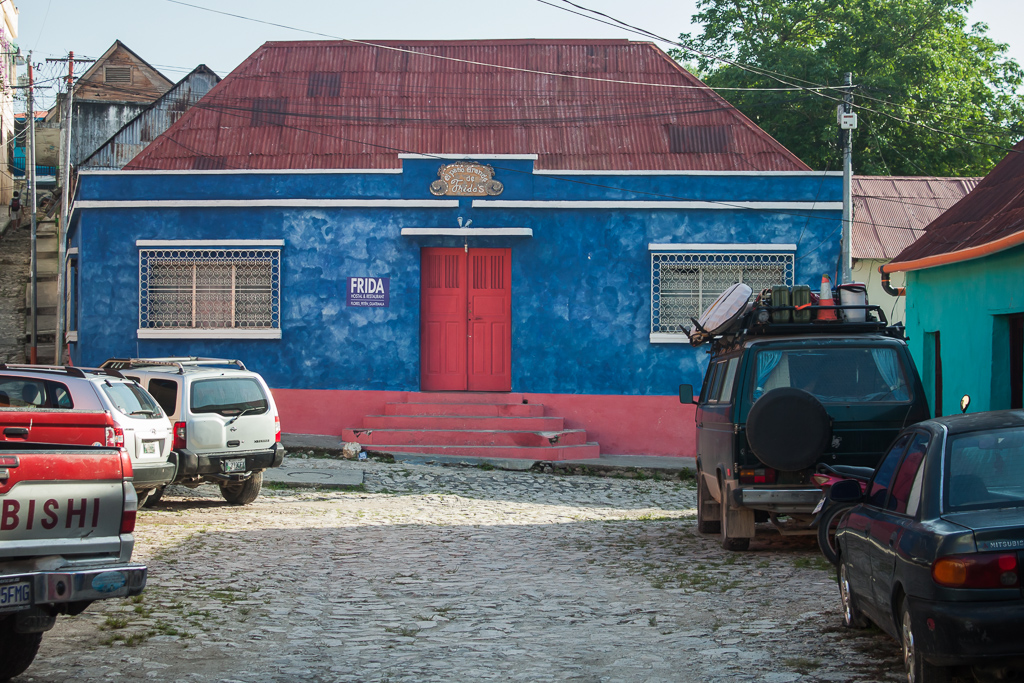
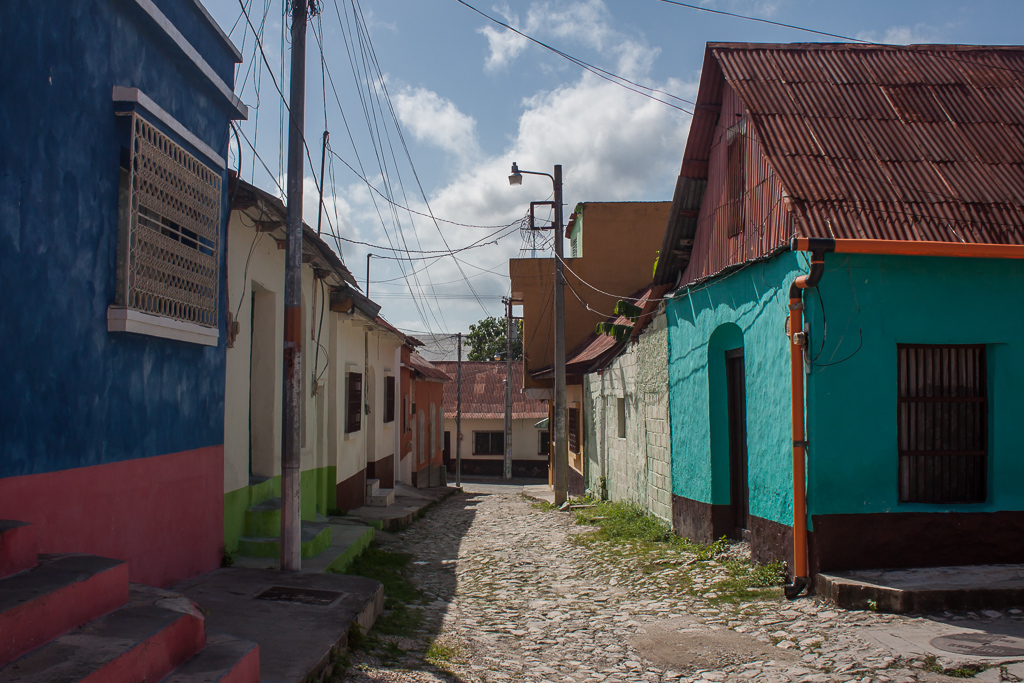

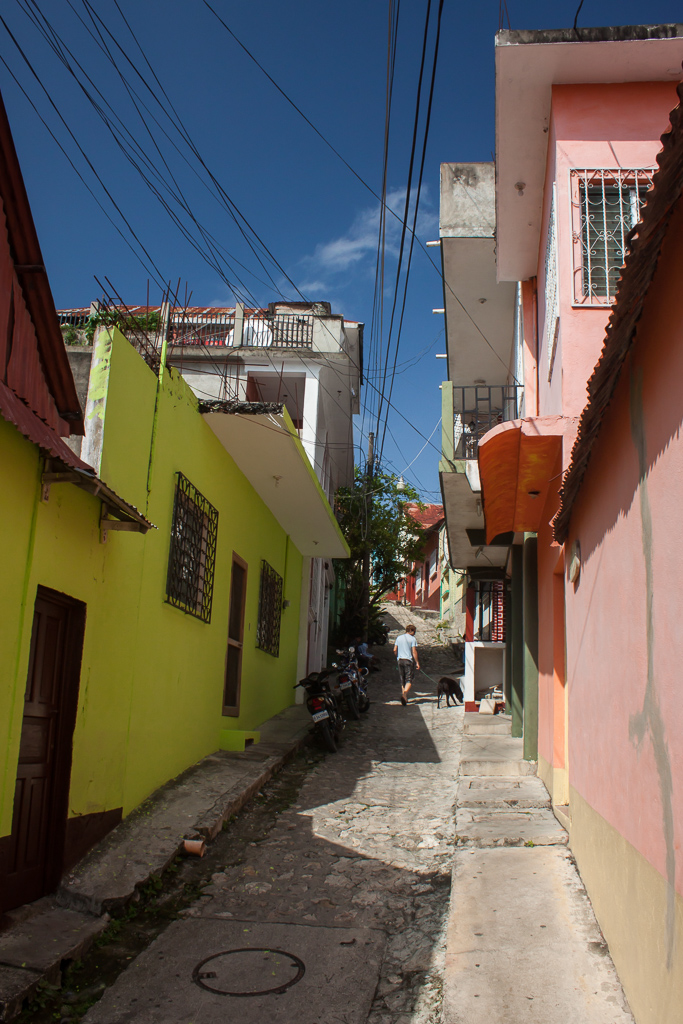

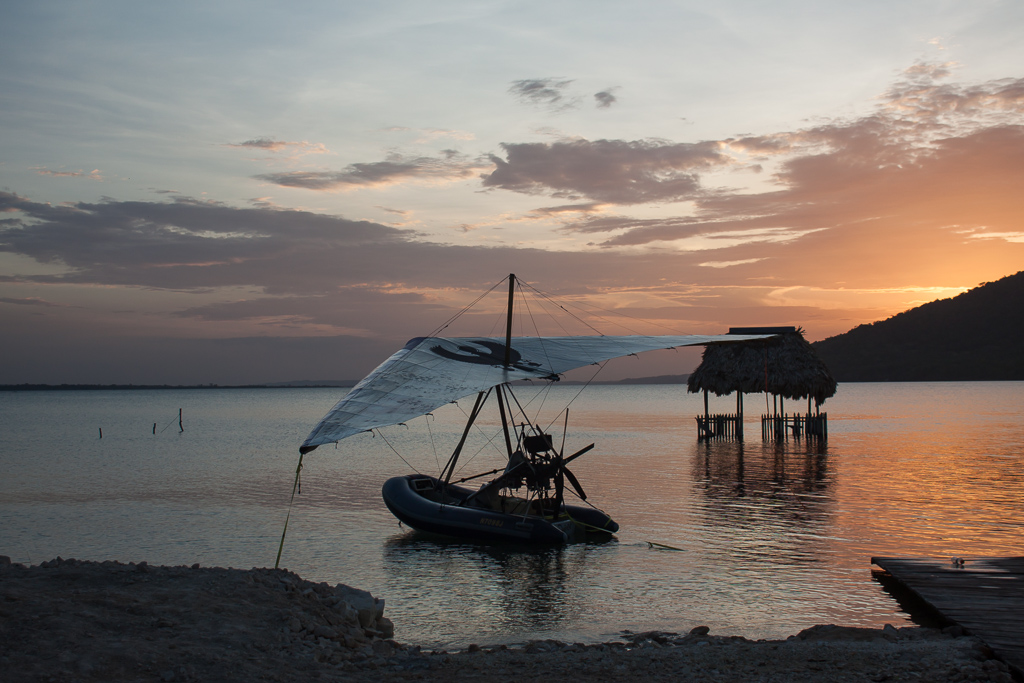
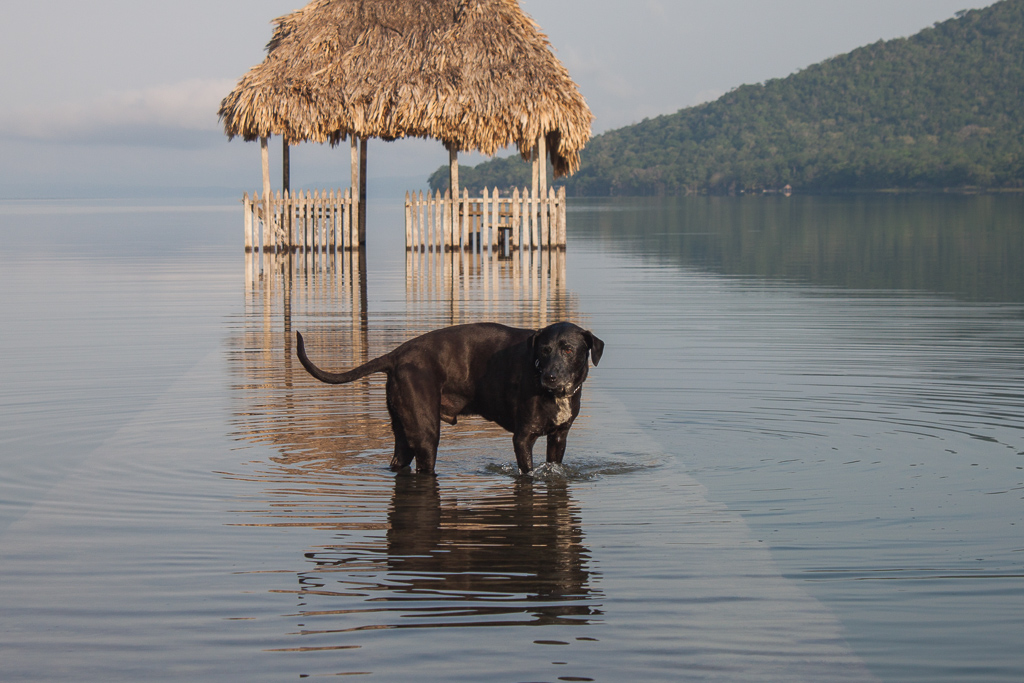
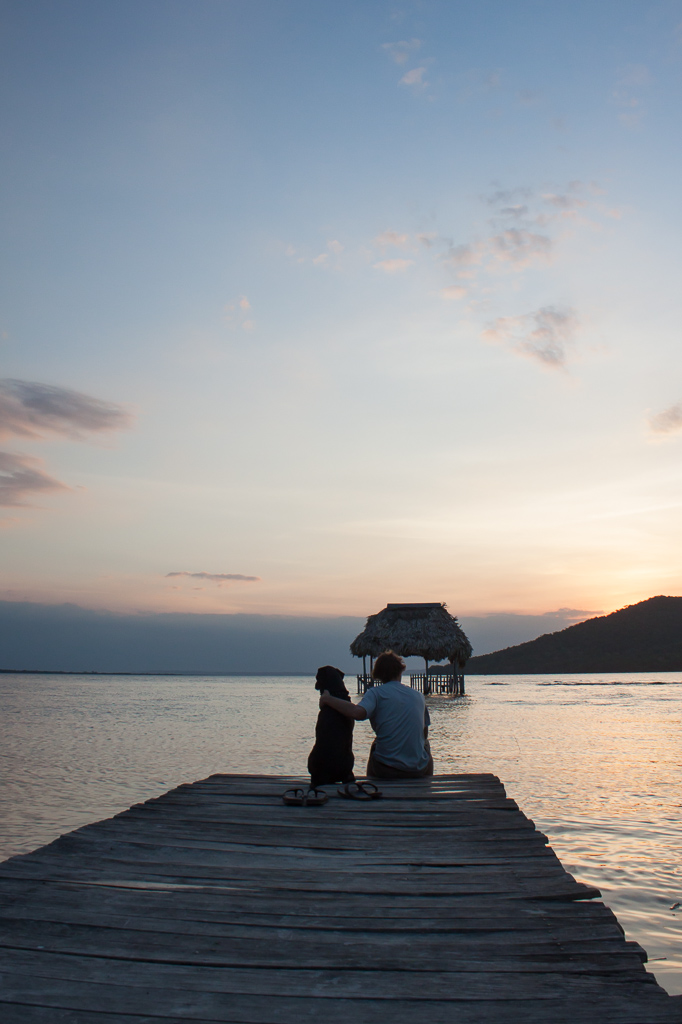
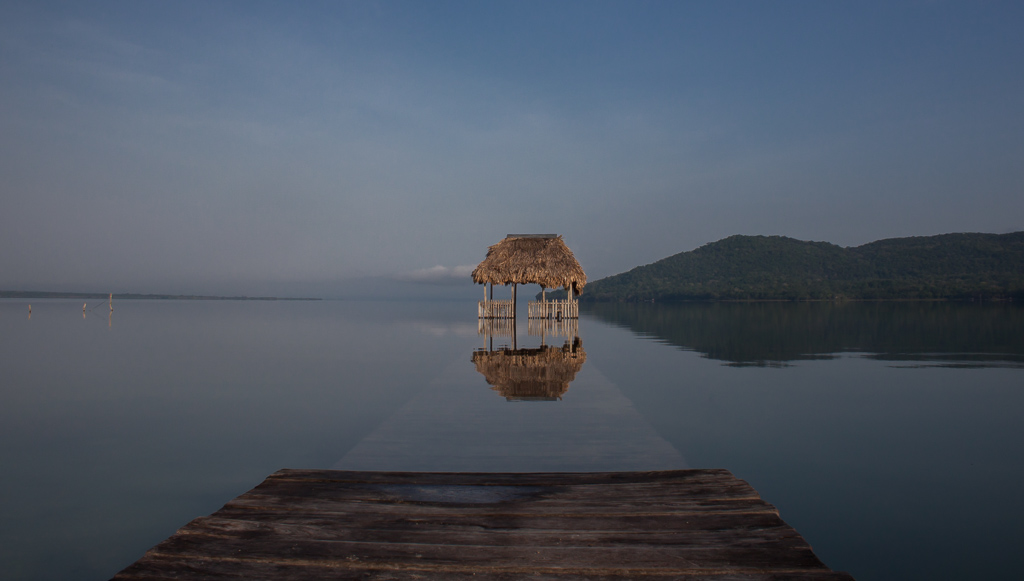






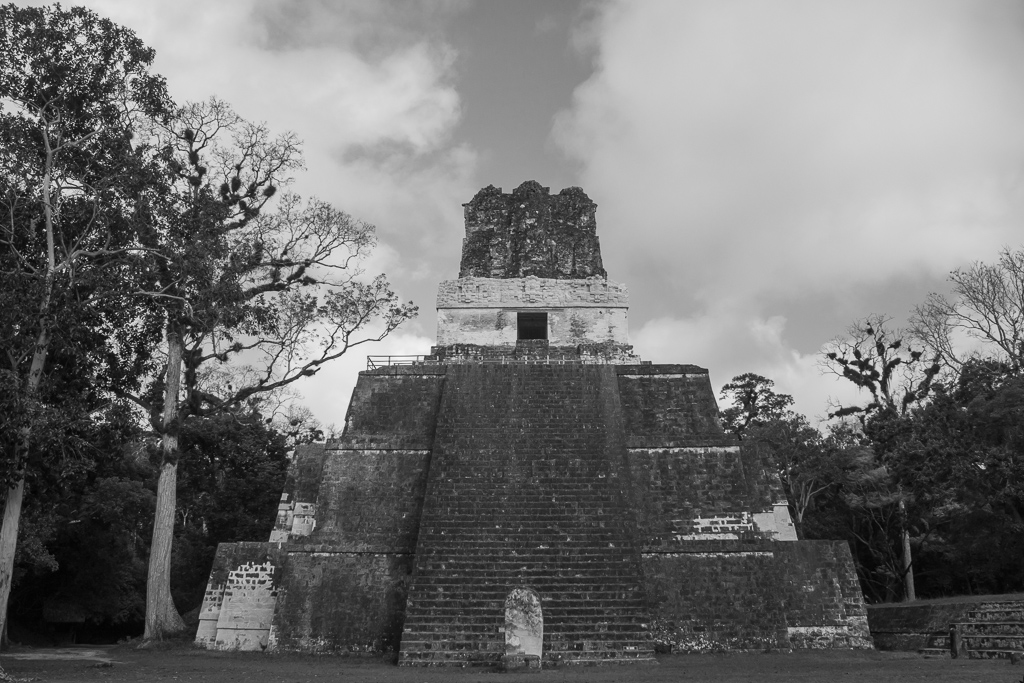

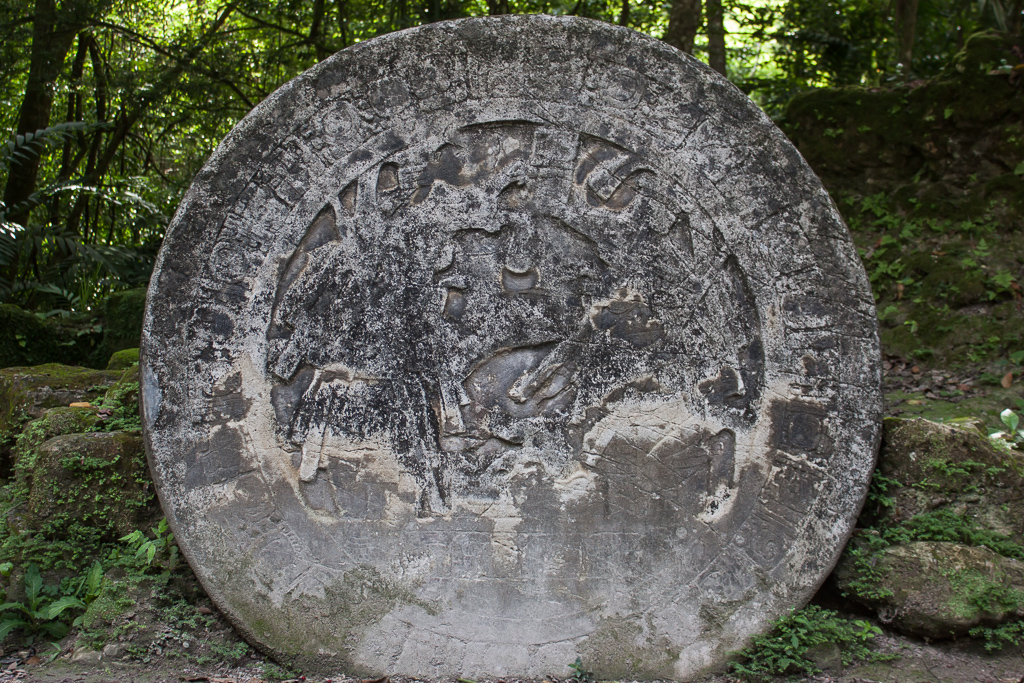









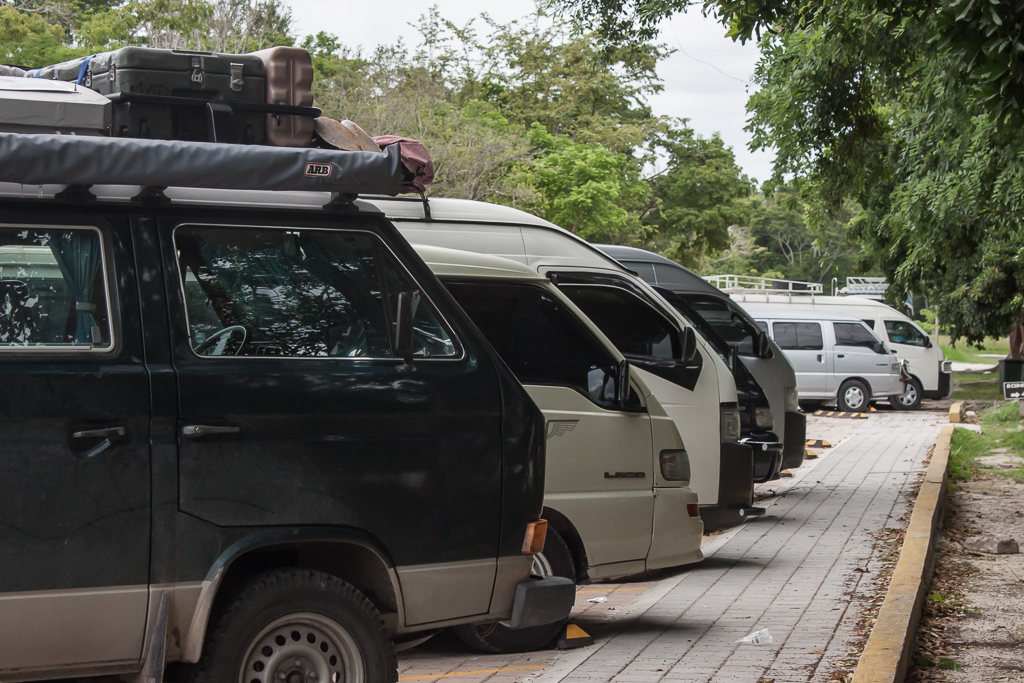




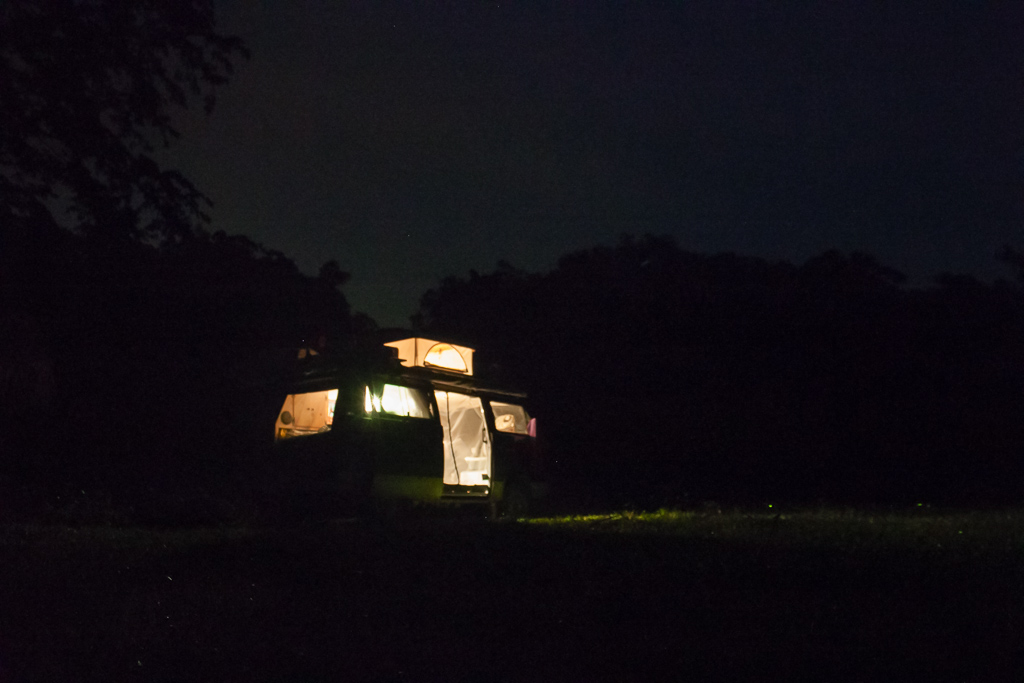


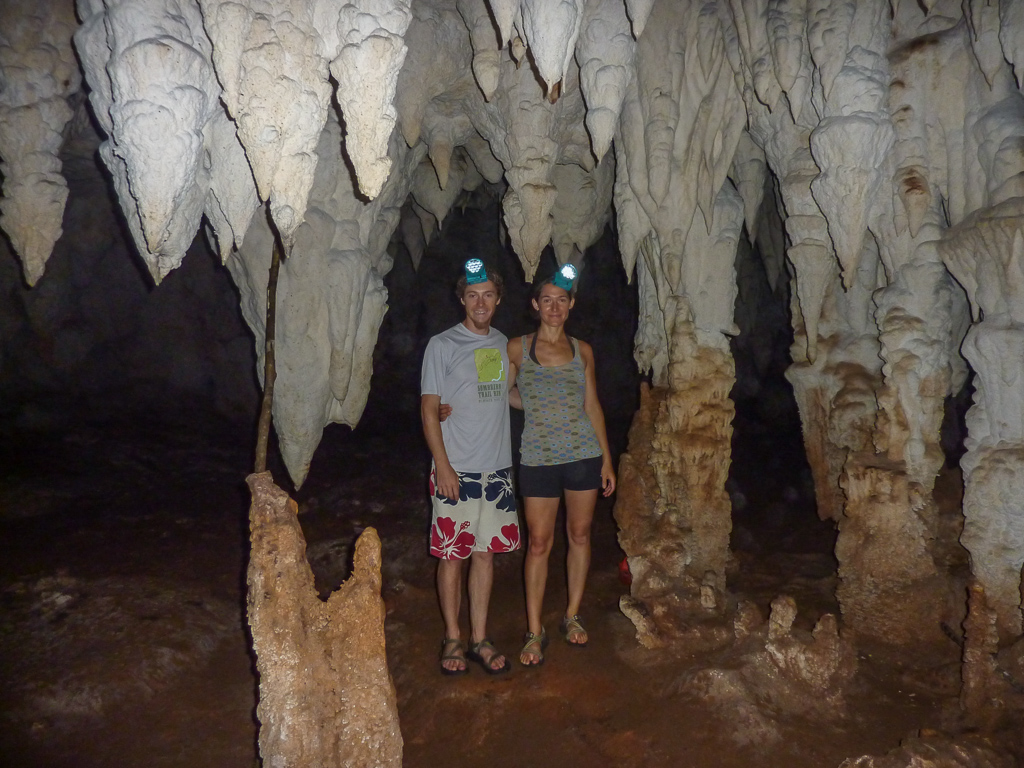



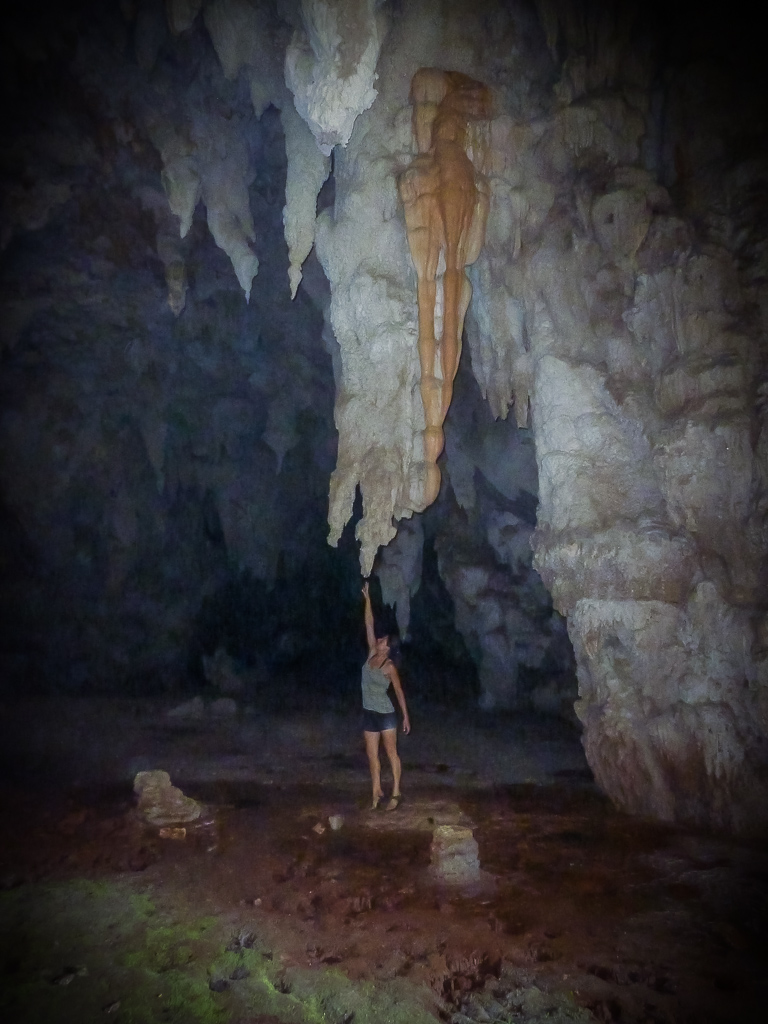




Emily, that is one awesome picture with the stalactite!
We’re back in the Bay Area, and envying you guys! Funny you thought the bridge was the worst part of the road to Semuc Champey. For us it was the road itself. Then again, our Westy is not only 2WD but also automatic 🙂
Thank goodness for granny gear and beefy tires!
Glad to hear you made it home safe and sound. We’ll have to meet up and exchange stories whenever we make it back to California.
Great photos, you two! I especially like the one of the ceiba tree in Tikal. Thanks so much for taking the time to document your trip so well so that we can share just a bit in your adventure.
Excellent Mayan jungle shots. Thanks for sharing the adventure
I am so enjoying your adventurous journey. I love Palenque , but it likes like Tikal is even more amazing…especially with the thatching on the roofs!
That bridge shot might have scared me off. Turning around wasn’t an option though, was it?
I am so grateful, enthralled, and excited for this vicarious living!
Thank you.
I can’t believe you almost skipped Tikal!
I know, right!? We’re so glad we ended up going!